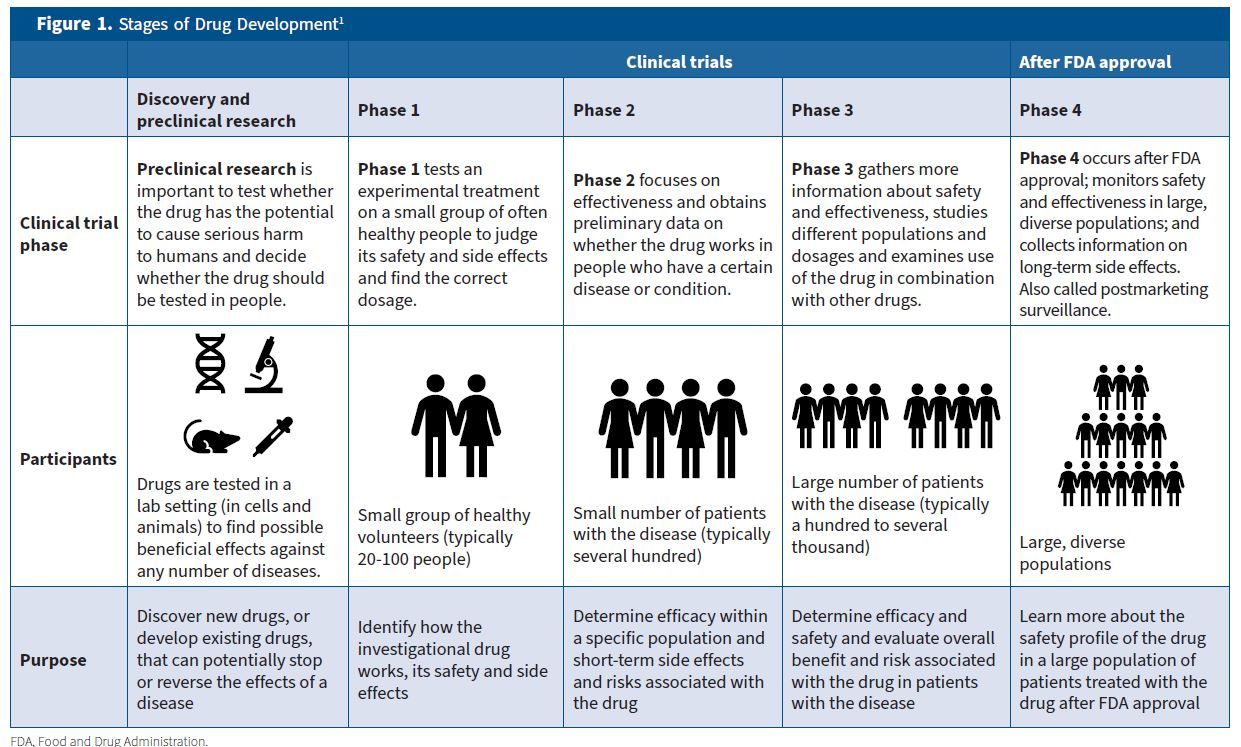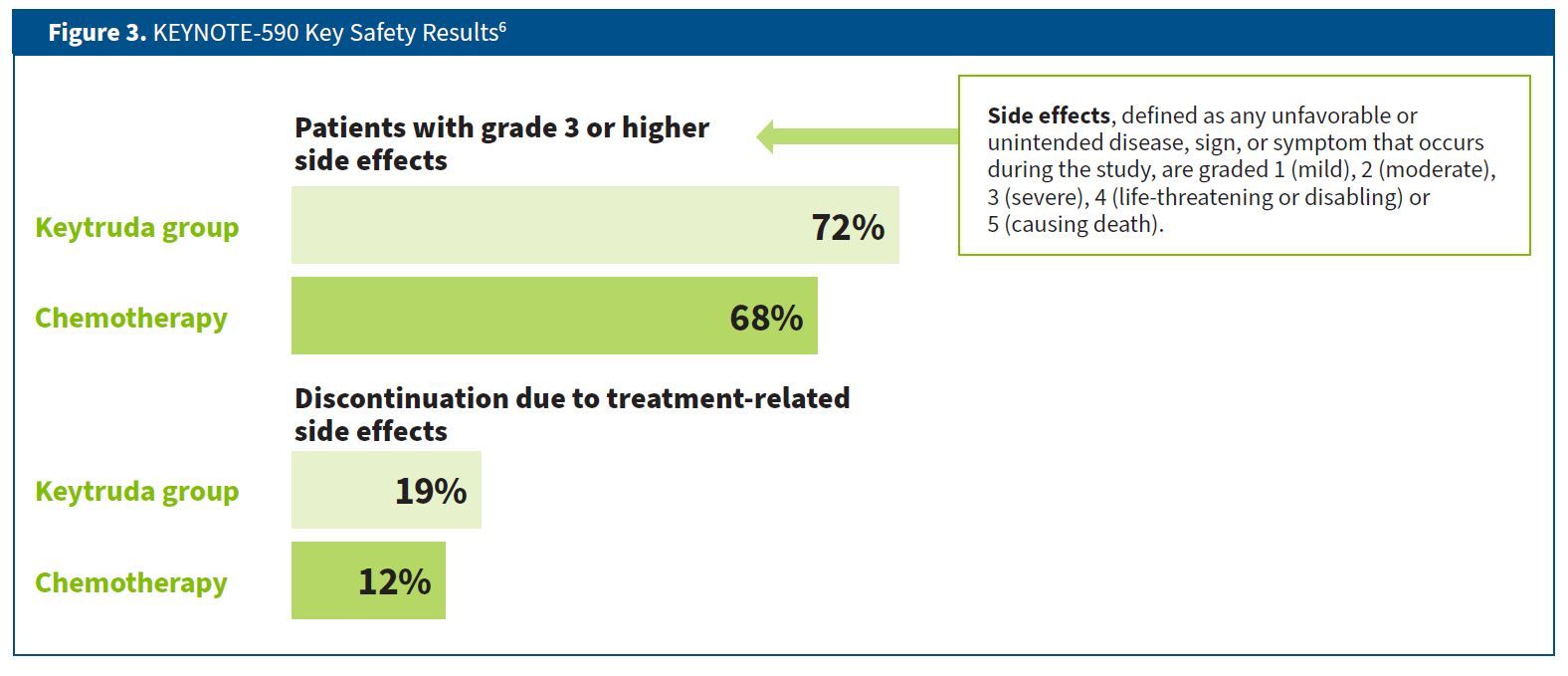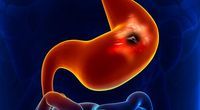Article
ESMO 2020: Phase 3 KEYNOTE-590 Trial
The Educated Patient®: Research Updates provides current clinical updates for different disease states. The following information is for educational purposes and is not medical advice.
FOR YOUR REFERENCE: What Are Clinical Trials?
Clinical trials determine whether a drug works in humans and if it is safe and effective. To find out whether a drug can be approved for use, the Food and Drug Administration (FDA) requires four phases of a clinical trial. The number of participants increases in each phase, starting from 20 to 80 people for a phase 1 trial to up to 3,000 for a phase 3 trial (Figure 1).1
- Phase 1: tests an experimental treatment on a small group of
often healthy people to judge its safety and side effects and find the correct dosage. - Phase 2: focuses on effectiveness and obtains preliminary data
on whether the drug works in people who have a certain disease
or condition. - Phase 3: gathers more information about safety and effectiveness, studies different populations and dosages and examines use of the drug in combination with other drugs.
- Phase 4: occurs after FDA approval; monitors safety and effectiveness in large, diverse populations; and collects information on long-term side effects.

FOR YOUR REFERENCE: What Is Gastroesophageal Junction Cancer?
Cancer of the esophagus (or esophageal cancer) starts when cells in the lining of the esophagus begin to grow out of control. Esophageal cancer can start anywhere along the esophagus, which in adults is usually 11 to 13 inches long. The lower part of the esophagus, where it connects to the stomach, is called the gastroesophageal (GE) junction. The two main types of esophageal cancer are squamous cell carcinoma, which most commonly starts in the neck and upper chest region, and adenocarcinomas, which start in gland cells (cells that make mucus) in the lower third of the esophagus. Adenocarcinomas that start at the GE junction also are treated as esophageal cancers.2
Treatment options for patients with GE junction cancer at various stages include the following2,3:
- Stage 1 esophageal cancer has grown into the esophagus wall and is treated with surgery to remove the part of the esophagus that contains the cancer, sometimes followed by chemoradiation (chemotherapy and radiation therapy given at the same time). Patients with more advanced stage 1 cancer may receive chemoradiation before surgery and/or an immunotherapy drug after surgery.
- For patients whose cancer has spread further in the esophagus or to nearby lymph nodes (stage 2) or through the esophagus wall and/or into nearby organs or tissues (stage 3), options include:
- Chemoradiation or chemotherapy followed by surgery.
- Surgery or chemoradiation alone.
- Immunotherapy.
- For GE junction cancer, chemotherapy plus immunotherapy (sometimes combined with targeted therapy for HER2-positive cancers)
- Stage 4 cancer has spread to distant lymph nodes or organs. Options include:
- Palliative laser surgery or electrocoagulation, esophageal stent, external or internal radiation therapy.
- For GE junction cancer, targeted therapy or immunotherapy, alone or with chemotherapy.
FOR YOUR REFERENCE: What Medications Were Investigated in the KEYNOTE-590 Trial
Keytruda (pembrolizumab) is a type of immunotherapy called a monoclonal antibody. It is designed to prevent cancer cells from multiplying inside the body.4 To understand how Keytruda works, it helps to first learn about two cell proteins called programmed death 1 (PD-1) and programmed death-ligand 1 (PD-L1). PD-1 is found on the body’s T cells, a type of immune cell that normally attacks and kills invaders such as cancer cells. PD-L1 is found on cancer cells as well as others. If PD-1 and PD-L1 bond together, this interaction stops the T cells from killing cancer cells and allows them to spread. Keytruda prevents PD-1 and PD-L1 from bonding, enabling T cells to continue killing cancer cells.5
ESMO 2020: Phase 3 KEYNOTE-590 Trial
The KEYNOTE-590 study is a phase 3 randomized international trial conducted in patients with locally advanced/unresectable (not fully removable) or metastatic adenocarcinoma, esophageal squamous cell carcinoma (ESCC) or Siewert type 1 esophagogastric junction adenocarcinoma (EGJ). The trial compared outcomes after treatment with Keytruda plus chemotherapy with results from those who took only chemotherapy.6
Primary end points were overall survival (OS) in patients with ESCC who had a PD-L1 combined positive score (CPS) of 10 or more tumors and OS and progression-free survival (PFS) in both patients with ESCC who had a PD-L1 combined positive score of 10 or more tumors and in all patients. The secondary end point was overall response rate (ORR), or the proportion of subjects whose tumors shrank or disappeared, in all patients.6
The study enrolled 749 patients, who were randomly selected to receive either Keytruda and chemotherapy or chemotherapy alone.6 Patients following the first regimen received Keytruda every three weeks.7 Those on the second regimen received a placebo every three weeks. All patients received chemotherapy in the form of cisplatin and 5-fluorouracil. Treatment cycles were repeated until patients experienced disease progression or unacceptable toxicity, withdrew for other reasons or completed the two-year study.6
The patients, most of whom (73%) had ESCC,7 filled out a quality of life (QOL) questionnaire at the beginning of the trial. They were then given QOL follow-up questionnaires every three weeks for six months and then every nine weeks up to one year or until treatment ceased.8
Results
The results of the KEYNOTE-590 trial showed that Keytruda plus chemotherapy outperformed chemotherapy alone in OS, with a median of 13.9 months in the first group and 8.8 months in the second for patients with ESCC CPS greater than or equal to 10. For all patients, the median OS on Keytruda plus chemotherapy was 12.4 months versus 9.8 months for those on chemotherapy alone (Figure 2).6

PFS was longer in patients with ESCC CPS of at least 10 who took Keytruda plus chemotherapy, with a median of 7.5 months versus 5.5 months, respectively. For all patients, median PFS was 6.3 months versus 5.8 months, respectively.6
The ORR in the Keytruda plus chemotherapy group versus chemotherapy alone was 45.0% compared with 29.3% in all patients, and the median duration of response was 8.3 months versus 6.0 months.6
Results from the patient questionnaires indicate that QOL held steady throughout the trial and was similar in both groups.8 Slightly more patients in the Keytruda plus chemotherapy group experienced grade 3 (severe) or higher side effects than those who received chemotherapy alone (72% versus 68%, respectively).6 The most common reactions, reported in at least 20% of all participants, included gastrointestinal complaints such as constipation, diarrhea, nausea and vomiting. Decreased appetite, fatigue and weight loss also occurred.9 Discontinuation rates related to the effects of treatment were 19% in the Keytruda plus chemotherapy group compared with 12% in the chemotherapy group.6

The study team concluded that Keytruda plus chemotherapy provides superior OS, PFS and ORR while offering acceptable toxicity risks for patients with advanced esophageal and EGJ cancer.6
Not all patients qualify for certain clinical trials. If you are interested in enrolling in a trial, talk with your doctor about which treatment options would be most appropriate for you.
Not all patients qualify for certain clinical trials. If you are interested in enrolling in a trial, talk with your doctor about which treatment options would be most appropriate for you.
FOR YOUR REFERENCE: Glossary of Terms
Adenocarcinoma: cancers that start in gland cells; often not fully removable with surgery
Chemoradiation: combines chemotherapy and radiation therapy to increase the effects of both
Chemotherapy: treatment that uses drugs to stop the growth of cancer cells either by killing the cells or by stopping them from dividing. These drugs are taken by mouth or injected and enter the bloodstream so they can help fight cancers that spread throughout the body. This can affect cancer cells and normal cells.
End point: in clinical trials, an event or outcome that can be measured objectively to determine whether the intervention being studied is beneficial
ESMO: European Society for Medical Oncology
Esophagus: a hollow, muscular tube that connects the throat to the stomach
Gastroesophageal junction: where the esophagus joins the stomach
Gland cells: cells that make mucus
HER2-positive: cells that have a protein called HER2 on their surface. In normal cells, HER2 helps control cell growth. Cancer cells that make too much HER2 may grow more quickly and are more likely to spread.
Laser surgery: treatment that uses intense, narrow beams of light to cut and destroy tissue, such as cancer tissue
Lymph nodes: part of the lymphatic system in the body’s immune system; carry fluid containing white blood cells, which help fight infections
Metastasize: when the cancer travels from the original tumor and spreads to other parts of the body such as tissues and organs
Monoclonal antibody: a type of protein made in the laboratory that can identify substances in the body, including cancer cells. Monoclonal antibodies can be used alone or to carry drugs, toxins, or radioactive substances directly to cancer cells.
Overall response rate: the percentage of people in a study or treatment group who have a partial or complete response to the treatment within a certain period of time
Overall survival: the length of time from either the date of diagnosis or the start of treatment for a disease that a patient is still alive
Palliative: given to improve the quality of life for patients who have a serious or life-threatening disease
Programmed death 1: a protein on the surface of T cells that helps keep the body’s immune responses in check
Programmed death-ligand 1: a protein found on some types of cancer cells
Programmed death-ligand 1 (PD-L1) combined positive score: a measure of the number of PD-L1-positive cells compared with the total number of tumor cells found
Progression-free survival: the length of time during and after the treatment of a disease that a patient lives with the disease but it does not get worse
Quality of life: the patient’s overall enjoyment of life. Many clinical trials assess the effects of cancer and its treatment on quality of life. These studies measure aspects of an individual’s sense of well-being and ability to carry out activities of daily living.
Side effect: any unfavorable or unintended disease, sign or symptom that occurs during the time a patient is receiving a medical treatment or procedure
Siewert type 1: cancers located between 1 and 5 centimeters above the gastroesophageal juncti
Squamous cell carcinoma: cancer that begins in squamous cells found in the tissue that forms the surface of the skin, the lining of the hollow organs of the body and the lining of the respiratory and digestive tracts
Targeted therapy: a cancer treatment that uses drugs to target specific aspects of the cancer cells
Tumor: an abnormal mass of tissue that forms when cells grow and divide more than they should or do not die when they should
References
- What are clinical trials and studies? National Institute on Aging. Accessed March 15, 2021. https://www.nia.nih.gov/health/what-are-clinical-trials-and-studies
- What is cancer of the esophagus? American Cancer Society. Updated March 20, 2020. Accessed May 14, 2021. https://www.cancer.org/cancer/esophagus-cancer/about/what-is-cancer-of-the-esophagus.html
- Treating esophageal cancer by stage. American Cancer Society. Updated May 21, 2021. Accessed May 14, 2021. https://www.cancer.org/cancer/esophagus-cancer/treating/by-stage.html
- How Keytruda works. Merck Oncology. Accessed May 1, 2021. https://www.keytruda.com/how-does-keytruda-work/
- Prasad V, Kaestner V. Nivolumab and pembrolizumab: monoclonal antibodies against programmed cell death-1 (PD-1) that are interchangeable. Semin Oncol. 2017;44(2):132-135. doi:10.1053/j.seminoncol.2017.06.007
- Kato K, Sun JM, Shah MA, et al. LBA8_PR-pembrolizumab plus chemotherapy versus chemotherapy as first-line therapy in patients with advanced esophageal cancer: the phase 3 KEYNOTE-590 study. Ann Oncol. 2020;31(4):S1192-S1193. doi:10.1016/j.annonc.2020.08.2298
- Bosworth T. KEYNOTE-590 trial: pembrolizumab improves OS in esophageal cancer. Clinical Oncology News. December 7, 2020. Accessed May 14, 2021. https://www.clinicaloncology.com/Solid-Tumors/Article/08-20/-KEYNOTE-590-Trial-Pembrolizumab-Improves-OS-in-Esophageal-Cancer-/61289
- Mansoor W, Kulkarni AS, Kato K, et al. Health-related quality of life (HRQoL) of pembrolizumab plus chemotherapy versus chemotherapy as first-line therapy in patients with advanced esophageal cancer: the phase III KEYNOTE-590 study. J Clin Oncol. 2021;39(3):168. doi:10.1200/JCO.2021.39.3_suppl.168
- FDA approved pembrolizumab for esophageal or GEJ carcinoma. Food and Drug Administration. Updated March 23, 2021. Accessed May 3, 2021. FDA. https://www. gov/drugs/resources-information-approved-drugs/fda-approves-pembrolizumab-esophageal-or-gej-carcinoma



